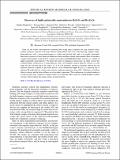| dc.contributor.author | Filippone, Stephen | |
| dc.contributor.author | Zhao, Boyang | |
| dc.contributor.author | Niu, Shanyuan | |
| dc.contributor.author | Koocher, Nathan Z. | |
| dc.contributor.author | Silevitch, Daniel | |
| dc.contributor.author | Fina, Ignasi | |
| dc.contributor.author | Rondinelli, James M. | |
| dc.contributor.author | Ravichandran, Jayakanth | |
| dc.contributor.author | Jaramillo, R. | |
| dc.date.accessioned | 2022-01-31T18:11:47Z | |
| dc.date.available | 2022-01-31T18:11:47Z | |
| dc.date.issued | 2020-09-08 | |
| dc.identifier.issn | 2475-9953 | |
| dc.identifier.uri | https://hdl.handle.net/1721.1/139805 | |
| dc.description.abstract | There are few known semiconductors exhibiting both strong optical response and large dielectric polarizability. Inorganic materials with large dielectric polarizability tend to be wide-band gap complex oxides. Semiconductors with a strong photoresponse to visible and infrared light tend to be weakly polarizable. Interesting exceptions to these trends are halide perovskites and phase-change chalcogenides. Here we introduce complex chalcogenides in the Ba-Zr-S system in perovskite and Ruddlesden-Popper structures as a family of highly polarizable semiconductors. We report the results of impedance spectroscopy on single crystals that establish
BaZr
S
3
and
Ba
3
Zr
2
S
7
as semiconductors with a low-frequency relative dielectric constant
ɛ
0
in the range 50–100 and band gap in the range 1.3–1.8 eV. Our electronic structure calculations indicate that the enhanced dielectric response in perovskite
BaZr
S
3
versus Ruddlesden-Popper
Ba
3
Zr
2
S
7
is primarily due to enhanced IR mode-effective charges and variations in phonon frequencies along ⟨001⟩; differences in the Born effective charges and the lattice stiffness are of secondary importance. This combination of covalent bonding in crystal structures more common to complex oxides, but comprising sulfur, results in a sizable Fröhlich coupling constant, which suggests that charge carriers are large polarons. | en_US |
| dc.description.sponsorship | National Science Foundation (NSF) | en_US |
| dc.publisher | American Physical Society (APS) | en_US |
| dc.relation.isversionof | 10.1103/physrevmaterials.4.091601 | en_US |
| dc.rights | Article is made available in accordance with the publisher's policy and may be subject to US copyright law. Please refer to the publisher's site for terms of use. | en_US |
| dc.source | Prof. Jaramillo | en_US |
| dc.subject | Physics and Astronomy (miscellaneous) | en_US |
| dc.subject | General Materials Science | en_US |
| dc.title | Discovery of highly polarizable semiconductors BaZrS3 and Ba3Zr2S7 | en_US |
| dc.type | Article | en_US |
| dc.identifier.citation | Filippone, Stephen, Zhao, Boyang, Niu, Shanyuan, Koocher, Nathan Z., Silevitch, Daniel et al. 2020. "Discovery of highly polarizable semiconductors BaZrS3 and Ba3Zr2S7." Physical Review Materials, 4 (9). | |
| dc.contributor.department | Massachusetts Institute of Technology. Department of Materials Science and Engineering | |
| dc.relation.journal | Physical Review Materials | en_US |
| dc.eprint.version | Final published version | en_US |
| dc.type.uri | http://purl.org/eprint/type/JournalArticle | en_US |
| eprint.status | http://purl.org/eprint/status/PeerReviewed | en_US |
| dc.identifier.doi | 10.1103/PhysRevMaterials.4.091601 | |
| dspace.date.submission | 2022-01-31T13:30:32Z | |
| mit.journal.volume | 4 | en_US |
| mit.journal.issue | 9 | en_US |
| mit.license | PUBLISHER_POLICY | |
| mit.license | OPEN_ACCESS_POLICY | |
| mit.metadata.status | Authority Work and Publication Information Needed | en_US |

